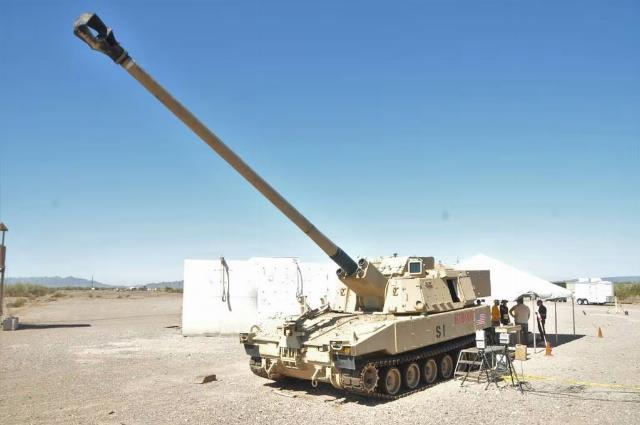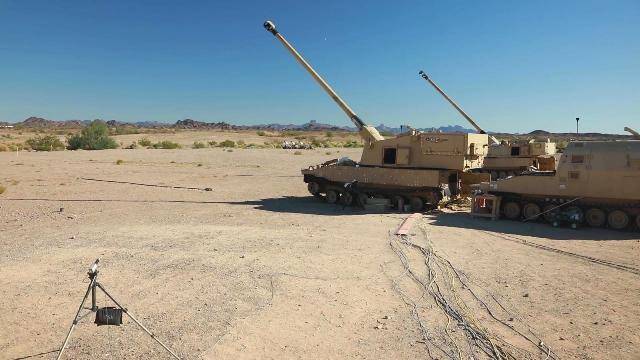As reported by the American edition of Defense News in the article by Jen Judson "US Army scraps Extended Range Cannon Artillery prototype effort" ("The US Army canceled the development of prototypes under the Extended Range Cannon Artillery program"), on March 8, 2024, Deputy Secretary of the US Army for Procurement, Logistics and Technology Doug Bush stated that the American army based on the results of prototype tests, the further development of the promising 155mm/58 long-range self-propelled howitzer M1299 was canceled under the Extended Range Cannon Artillery (ERCA) program.

One of the prototypes of the American 155mm/58 long-range self-propelled howitzer M1299 under the Extended Range Cannon Artillery (ERCA) program (c) Ana Henderson / US Army
"We completed the prototype testing phase last fall," Doug Bush said on March 8 at a briefing for journalists on the draft budget of the US Army for fiscal year 2025. - "Unfortunately, [it turned out to be] not successful enough to go directly to production."
The new plan, as stated, is to, after conducting an "exhaustive" study of advanced tactical firepower by the US Army Advanced Development Command (Army Futures Command), designed to confirm the elements of requirements for range artillery systems, this summer evaluate the existing options offered by the industry "to get an idea of the level of development of these systems".
A year ago, Doug Bush said that the extended ERCA tests revealed "engineering problems." First of all, this concerns, Bush said a year ago. Observations during early prototype tests showed excessive wear of the gun barrel after firing even a relatively small number of shots.
Back in the summer of 2023, the head of the U.S. Army's Advanced Development Command, General James Rainey, told Defense News that the army was working on a new strategy for conventional fire damage, expected by the end of the calendar year. According to Rainey, the strategy will determine both the capabilities and the potential of what exists and what the U.S. army may need. According to Bush, depending on the conclusions that will be drawn in this strategy, there are many options that the US army can consider to meet the need for a long-range artillery system.
The U.S. Army was able to conduct a number of successful tests of ERCA prototypes, including hitting a target at a distance of 70 km (43 miles) at the Yuma training ground in Arizona in December 2020 using the Excalibur guided extended-range artillery projectile. The problems with the gun were mainly related to the length of the barrel and its ability to withstand a large number of shots without excessive wear.
Now it is planned to review and test the currently existing artillery systems. According to Bush, the U.S. Army will then select one of them for production if it proves promising.
"This is a transition from developing something new to working with what is available both domestically and abroad to get the required range," he added, "since the study of firepower has confirmed that range and power of destruction are still necessary, so we want to find another way to achieve goals".
The U.S. Army is requesting $55 million from its budget for fiscal year 2025 to continue new efforts to find extended-range artillery systems. The army also plans to continue developing new munitions, which it has already worked on under the ERCA program, Bush noted.
From the bmpd side, we recall that the promising American 155 mm/58 long-range self-propelled howitzer HM1299 was created as part of the first stage (Increment 1) of the Extended Range Cannon Artillery (ERCA) program since 2016. The ERCA program was implemented under the head role of BAE Systems Corporation in partnership with the Weapons Center of the U.S. Army Combat Capability Development Command and the U.S. Army Arsenal in Picatinny.
The basis of the design of the XM1299 was the new 155 mm XM208 cannon mount with a swinging part of the XM907 with a barrel length of 58 calibers, developed by the Bennett Army Laboratory and the Arsenal in Picatinny. It passed fire tests on two experimental self-propelled installations in 2018 at the Yuma training ground - one of these installations was carried out on the chassis of the 155 mm self-propelled howitzer M109A6, and the other on the chassis of the self-propelled howitzer M109A7 PIP.
In July 2019, BAE Systems received a US Army contract worth $ 45 million for the full-scale development and manufacture of the first prototype XM1299 based on the M109A7 chassis. In total, five prototypes of the M1299 and 18 pre-production systems (a divisional set for military tests) have been manufactured to date, the delivery of the latter began in 2021. At the next stage, it was planned to equip the M1299 with an automatic loader, but problems with increasing the weight of the ACS left work in this direction in limbo. although prototype tests with such a system were conducted in 2021-2022.
It is stated that the firing range of the XM907 reaches more than 70 km when using an active-reactive correctable (inertial-satellite-guided) General Dynamics XM1113 RAP projectile with a new "supercharger" XM654. The XM1113 RAP projectile, when fired from a standard 155mm/39 howitzer, reaches a range of more than 40 km. A further development of the XM1113 was the XM1113 ER (XM1210) projectile, which was launched in Yuma in 2021. Finally, in December 2022, an ultra-long-range BAE Systems XM1155 subcalibre correctable projectile was fired from a modified XM907E2 cannon at a distance of 110 km (68 miles).
Note that problems with low barrel life are a long-standing scourge of all projects of long-range artillery systems, and, according to available information, are also characteristic of Russian promising self-propelled guns for the OKR "Coalition".

Two pre-production samples of the American 155mm/58 long-range self-propelled howitzer M1299 under the Extended Range Cannon Artillery (ERCA) program during experimental exercises under the US Army Project Convergence 21 program. An armored ammunition transport vehicle created for the M1299 is also visible. October 2021 (c) U.S. Army




